他のメンバー : 池田 潤 谷口 孝介 矢澤 真人 石田 尊 志田 泰盛 土井 裕人 小野 基 綿抜 豊昭 阪口 哲男 鈴木 伸崇 時井 真紀 松村 敦
他機関 : 永崎 研宣
キーワード:人文情報学、デジタルアーカイブ、メタデータ、知の構造化
http://www.jinsha.tsukuba.ac.jp/research_group/tsdh
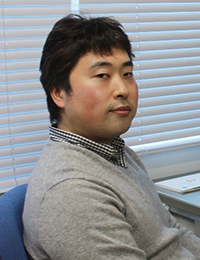 デジタル技術の登場以来、人文学の研究対象となる資料は電子画像としてコンピュータで扱えるようになりました。デジタルアーカイブと称される活動ですが、デジタルカメラで撮った写真に始まり、高精細化、データベース化といった課題を解決するべく日々進歩しています。近年では、ただ画像を提供するだけでなく、国際的な規格に基づいてその資料に関する付加価値的な情報も付けて公開する取り組みが重要となってきています。
デジタル技術の登場以来、人文学の研究対象となる資料は電子画像としてコンピュータで扱えるようになりました。デジタルアーカイブと称される活動ですが、デジタルカメラで撮った写真に始まり、高精細化、データベース化といった課題を解決するべく日々進歩しています。近年では、ただ画像を提供するだけでなく、国際的な規格に基づいてその資料に関する付加価値的な情報も付けて公開する取り組みが重要となってきています。
デジタル・ヒューマニティーズ・リサーチユニットではこれら歴史資料を読み解く研究を、情報学と人文社会科学両方の研究者が協力して行っており、筑波大学附属図書館が所蔵している古典資料を国際規格のデータにし、人文学の専門家による付加的な情報とリンクして世界中どこからでもアクセスできる環境づくりに取り組んでいます。
データ化技術、人文社会科学、図書館情報学の3分野の研究者で史料の国際規格化に取り組む
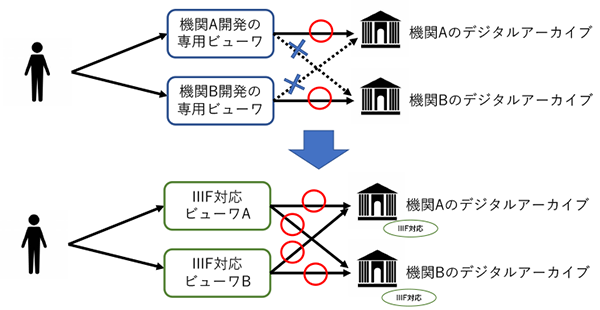
図1:従来のビューワとIIIF対応ビューワの相関図
本ユニットは、筑波大学附属図書館に所蔵されている古典資料を「IIIF(International Image Interoperability Framework)」という規格に対応させたデータ化に取り組んでいます。IIIFは国際的な画像相互運用のための枠組みで、JPEGやPDFなどの単なる画像化にはないメリットがあります。
一番の特徴として、特定のビューワに限定されることのないデータ提供が可能なため、インターネット上のホームページを好きなブラウザで閲覧するように、好きなIIIF対応ビューワでデジタルコンテンツにアクセスができるようになります(図1)。また、資料に関する解説を付けたり、編集をしたり、クレジットや著作権の問題も考慮しながら二次利用も容易にできるようになるため、成果物の活用可能性も広がります。資料の国際的な共有や研究を促進するIIIFに、筑波大学附属図書館の所蔵物を対応させ、本学の研究者の知見とともに広く世界に公開していくことが本ユニットの目標です。
新時代のデジタルアーカイブを担う
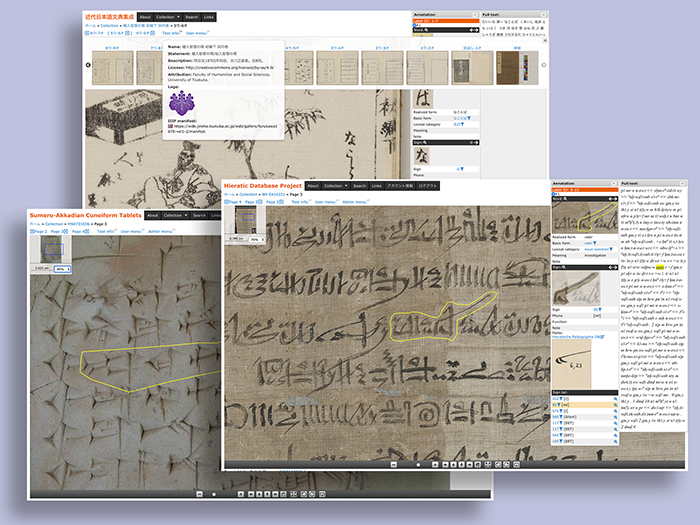
図2:アノテーション付きデータベースの例
本ユニットメンバーが作成したシステムに、古代エジプト文字のアノテーション付きデータベースがあります(図2)。IIIFのアノテーション付与機能を使って、専門家が古代エジプト語の理解を助けるための情報を付与した状態でコンテンツを公開しています。ただデジタルデータをダウンロード可能にするだけのデジタルアーカイブは既に時代遅れになりつつあり、資料の提供方法の高度化が今後の人文学研究を深める大きな要素になっています。
資料に解説を付ける取り組みは既に各研究機関で行われていますが、それだけにとどまらず関連する資料の検索方法や、コンピュータが自動的に推奨、提供する方法の研究など、研究課題は多岐にわたります。
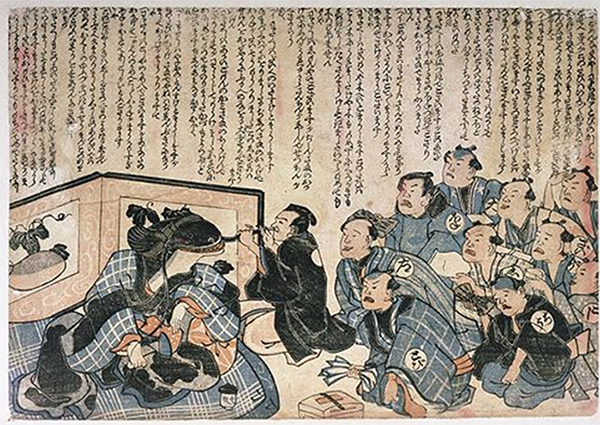
図3:デジタルアーカイブ化された安政地震を伝える鯰絵
まずは本学図書館所蔵の資料のデジタル化を中心に取り組み、国民の共有財産である古典資料を広く利用可能にすることを目指します。筑波大学附属図書館は国内でも古い資料の所蔵が多い図書館であり、有名な資料の一例として、安政地震を伝える鯰絵(図3)などがあります。これら所蔵物をグローバルに公開することにやりがいを感じています。
また、ワークショップの開催などを通して、最新のデジタルアーカイブ技術の利用促進にも貢献し、国内における中心的な役割を担うべく取り組んでいきます。
社会への貢献・実績
- 筑波大学附属図書館の古典資料の国際規格化(~2020年)
- 古文書の自動書き下しシステムの開発(~2020年)
- 人文科学とコンピュータシンポジウム2020開催校
- WDB: General-purpose Platform for Database System of Annotated Images
https://wdb.jinsha.tsukuba.ac.jp/
取材日:2020年2月5日
Accelerating Humanities and Social Science Research by Digitizing Ancient Documents
Unit members : Ikeda, Jun Taniguchi, Kousuke Yazawa, Makoto Ishida, Takeru Shida, Taisei Doi, Hiroto Ono, Motoi Watanuki, Toyoaki Sakaguchi, Tetsuo Suzuki, Nobutaka Tokii, Maki Matsumura, Atsushi
Other agencies : Nagasaki, Kiyonori
Unit name: The Tsukuba Research Group for the Digital Humanities
Key words: digital humanities, digital archive, metadata, knowledge structuring
http://www.jinsha.tsukuba.ac.jp/research_group/tsdh

Digital technology has made it possible to handle documents subject to humanities research as electronic images using computers. This activity, called “digital archives”, started by processing photographs taken with digital cameras, is advancing day by day to address various challenges, such as converting documents into high-resolution images and organizing them as databases. Recently, the importance of publishing not only images, but also value-added information regarding these documents based on international standards is increasing.
In the Tsukuba Research Group for the Digital Humanities, informatics researchers and those specializing in humanities and social sciences are collaborating to decipher historical documents. We aim to make ancient documents stored in the University of Tsukuba Library accessible from anywhere in the world by converting them into data that meet international standards and linking them with additional information from humanities specialists.
International standardization of historical documents by researchers from three specialty areas: digitalization, humanities and society sciences, and library informatics
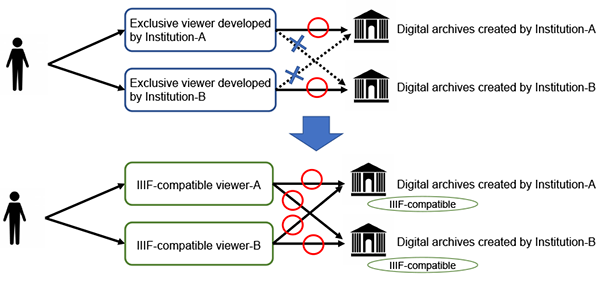
Figure 1: Correlation diagram between conventional and IIIF-compatible viewers
We digitalize ancient documents stored in the University of Tsukuba Library in compliance with the International Image Interoperability Framework (IIIF) standard. IIIF is a framework for international image interoperability, and there are several advantages to it compared with formats for simply creating image files such as JPEG and PDF.
One of the best features is that data are provided, regardless of the viewer type. Thus, you will be able to access digital contents using any IIIF-compatible viewer, just as you can view websites on the Internet using your favorite browser (Figure 1). IIIF also allows you to add explanations of documents, edit them, secondarily use them while considering credit and copyright issues, and, consequently, use deliverables more extensively. Our goal is to make the collections stored in the University of Tsukuba Library comply with IIIF, which promotes the international sharing and research of documents, and widely release them to the world, with findings from researchers belonging to the University of Tsukuba.
Contributing to new-generation digital archives

Figure 2: An example database with annotations
Our unit members have created various systems, including a database of ancient Egyptian scripts with annotations (Figure 2). This database releases contents to the public, with additional information to help viewers understand ancient Egyptian scripts using the annotation-adding function of IIIF. Digital archives only to download digital data are already out of date. The sophistication of methods to provide documents is essential to deepen future humanities research.
Some research institutes have already begun to add explanations to documents, but various challenges have yet to be addressed in research, including developing methods for viewers to search for related documents and those for computers to automatically recommend or present such documents.

Figure 3: Digitalized version of The Drawing of a Catfish recounting the Ansei Great Earthquakes
Our first step is to digitize the documents stored in the University of Tsukuba Library, and make these ancient documents, which are also a common property of the Japanese people, widely available. The University of Tsukuba Library is one of the Japanese libraries with many collections of ancient documents, and The Drawing of a Catfish, recounting the Ansei Great Earthquakes (Figure 3), represents its famous collections. We find it rewarding to globally release these collections.
These approaches will help us learn that researchers in various fields provide diverse interpretations for documents, and consequently promote humanities and social science research. We believe that they will also help even nonexperts understand documents, and expand the scope of this field.
We also aim to contribute to the promotion of the latest digital archive technology through workshops and other activities, and lead this field in Japan.
Social contributions and achievements
- International standardization of ancient documents stored in the University of Tsukuba Library (-2020)
- Development of an automatic transcription system for ancient documents (-2020)
- Hosting the IPSJ SIG Computers and the Humanities 2020
- WDB: General-purpose Platform for Database System of Annotated Images https://wdb.jinsha.tsukuba.ac.jp/
Interviewed on February 5, 2020
